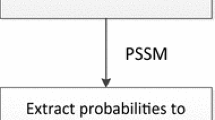Abstract
The success of a classification system depends heavily on two things: the tools being used and the features considered. For the bioinformatics applications the role of appropriate features has not been paid adequate importance. In this investigation we use two novel ideas. First, we use neural networks where each input node is associated with a gate. At the beginning of the training all gates are almost closed, i.e., no feature is allowed to enter the network. During the training, depending on the requirements, gates are either opened or closed. At the end of the training, gates corresponding to good features are completely opened while gates corresponding to bad features are closed more tightly. And of course, some gates may be partially open. So the network can not only select features in an online manner when the learning goes on, it also does some feature extraction. The second novel idea is to use a hierarchical machine learning architecture. Where at the first level the network classifies the data into four major folds : all alpha, all beta, alpha + beta and alpha / beta. And in the next level we have another set of networks, which further classifies the data into twenty seven folds. This approach helps us to achieve the following. The gating network is found to reduce the number of features drastically. It is interesting to observe that for the first level using just 50 features selected by the gating network we can get a comparable test accuracy as that using 125 features using neural classifiers. The process also helps us to get a better insight into the folding process. For example, tracking the evolution of different gates we can find which characteristics (features) of the data are more important for the folding process. And, of course, it reduces the computation time. The use of the hierarchical architecture helps us to get a better performance also.
Access this chapter
Tax calculation will be finalised at checkout
Purchases are for personal use only
Preview
Unable to display preview. Download preview PDF.
Similar content being viewed by others
References
I. Dubchak, I. Muchnik, S. R. Holbrook and S-H Kim, “Prediction of protein folding class using global description of amino acid sequence”, Proc. Natl. Acad. (Biophysics) USA, Vol. 92, pp. 8700–8704, Sep., 1995.
I. Dubchak, I. Muchnik, C. Mayor, I. Dralyuk, and S. H. Kim, “Recognition of a Protein Fold in the context of the SCOP Classification”, PROTEINS: Structure, Function and Genetics, Vol. 35, pp. 401–407, 1999.
P. Y. In Chou and G. D. Fashman, editor, “Prediction of protein structure and principles of protein conformation”, Plenum Press, New York:, pp. 549–586, 1989.
H. Nakashima, K. Nishikawa, and T. Ooi,“The folding type of a protein is relevant to the amino acid composition”, J. Biochem, Vol. 99, pp.152–162, 1986.
I. Dubchak, S. R. Holbrook, and S. H. Kim, “Prediction of protein folding class from amino acid composition”, PROTEINS: Structure, Function and Genetics, Vol. 16, pp. 79–91,1993.
N. R. Pal and K. Chintalapudi, “Connectionist system for feature selection,” Neural, Parallel and Scientific Computation, Vol. 5,No. 3, pp. 359–381, 1997.
R. De, N. R. Pal, and S. K. Pal, “Feature analysis: neural network and fuzzy set theoretic approaches”, Pattern Recognition, Vol. 30,No. 10, pp. 1579–1590, 1997.
K. Fukunaga and W. Koontz, “Applications of the karhunen-Loeve expansion to feature selection and ordering”, IEEE Trans. Comp., Vol. C-19, 1970.
K. L. Priddy, S. K. Rogers, D. W. Ruck, G. L. Tarr, and M. Kabrisby, “Bayesian Selection of Important Features for Feed-forward Neural Network”, NeuroComputing, Vol. 5, pp. 91–103, 1993.
A. Verikas and M. Bacauskiene, “Feature Selection with Neural Networks,” Pattern Recognition Letter, Vol. 23, pp. 1323–1335, 2002.
I F. Chung, C. D. Huang, Y. H. Shen, and C. T. Lin, “Recognition of StructureC lassification of Protein Folding by NN and SVM Hierarchical Learning Architecture”, Int. Conf. Neural Infor. Processing, ICONIP’03, Turkey, 2003.
I. Dubchak and C. H. Q. Ding, “Multi-class protein fold recognition using support vector machines and neural networks,” Bioinformatics, Vol. 17,No. 4, pp. 349–358, 2001.
Author information
Authors and Affiliations
Editor information
Editors and Affiliations
Rights and permissions
Copyright information
© 2003 Springer-Verlag Berlin Heidelberg
About this paper
Cite this paper
Huang, 2D., Chung, IF., Pal, N.R., Lin, CT. (2003). Machine Learning for Multi-class Protein Fold Classification Based on Neural Networks with Feature Gating. In: Kaynak, O., Alpaydin, E., Oja, E., Xu, L. (eds) Artificial Neural Networks and Neural Information Processing — ICANN/ICONIP 2003. ICANN ICONIP 2003 2003. Lecture Notes in Computer Science, vol 2714. Springer, Berlin, Heidelberg. https://doi.org/10.1007/3-540-44989-2_139
Download citation
DOI: https://doi.org/10.1007/3-540-44989-2_139
Published:
Publisher Name: Springer, Berlin, Heidelberg
Print ISBN: 978-3-540-40408-8
Online ISBN: 978-3-540-44989-8
eBook Packages: Springer Book Archive




